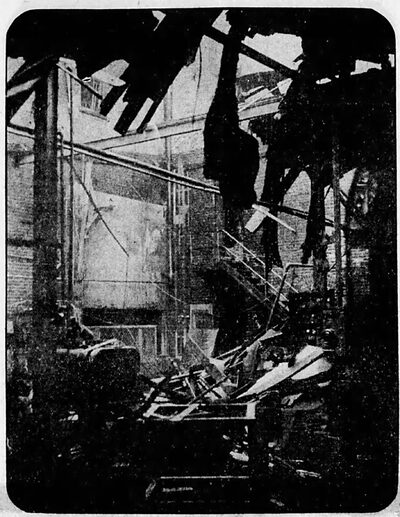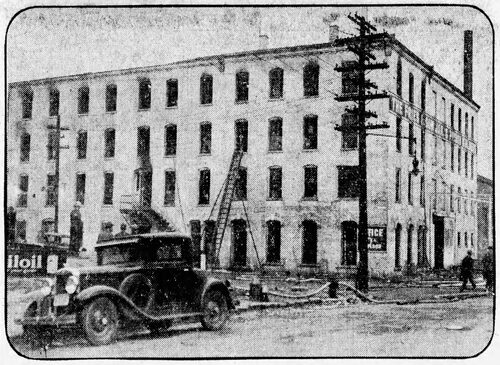[Newspaper]
Publication: The Kentucky Post
Covington, KY, United States
vol. 8, no. 119, p. 1, col. 7 - 8
FIRE SWEEPS FURNITURE STORE WAREHOUSE
DINE-SCHABELL STOCK DESTROYED
|
|
ABOVE is an interior view of the warehouse of the Dine-Schabell Furniture Co., Second-st. and Madison-av., Covington, swept by fire Sunday night. Below is an exterior of the building, the first and second floors of which are occupied by the Fries & Son Co., prison builders.
Loss of Stock and Building of Jail Builders Is
Placed at $110,000; Firemen Unable
To Trace Origin of Blaze.
Blackened ruins smoldered Monday in the Fries & Son Steel Construction and Engineering Co. building, Second-st. and Madison-av., Covington, and aftermath of a fire which Sunday night caused damage estimated at $110,000 to the building and its contents. The building was used as a warehouse by the Dine-Schabell Furniture Co.
Firemen of four cities - Covington, Newport, South Ft. Mitchell, and Ludlow - fought the raging blaze more than four hours before they were able to bring it under control.
The Fries and Son Co., which occupied the first two floors of the building, estimate their damage at approximately $70,000, while $40,000 worth of furniture belonging to the Dine-Schabell Co., Madison-av., Covington, stored in the upper two floors, was damaged.
Can't Trace Origin.
The fire, of undetermined origin, is believed by officials to have originated on one of the upper floors. The blaze was discovered at 8:55 p.m. When firemen, under Assistant Chief William McAvoy, arrived the fire had gained considerable headway.
McAvoy immediately sent in a general alarm and all Covington companies responded. Chief Frank Northcutt, whose off day was Sunday, soon arrived on the scene and took command of the fire-fighters. A call was sent to Newport, who sent one fire company, and to Ludlow, which sent its equipment and volunteers.
The building stands alone, and firemen were able to pour water into the blazing structure from all angles. However, they were hampered greatly because windows of the third and fourth floors were blocked with furniture.
Dense smoke in the building made the fire exceedingly difficult to fight for a time, but the roof soon collapsed, allowing the smoke to puff upward into the sky.
The blaze, which reddened the sky for miles around, attracted thousands of spectators to the scene. The Suspension Bridge was lined clear across with watchers, while many more stood on the Cincinnati shore of the Ohio River to view the spectacular blaze.
Streets Flooded With Smoke.
Smoke hung low, blowing across the river and filling downtown Cincinnati streets. The Cincinnati Fire Department was summoned to the Sinton Hotel, Fourth and Vine streets, by calls from persons who believed the hotel was afire.
Covington police were stationed at all intersections in the vicinity of the fire to keep traffic moving and to prevent a jam.
The flames gutted the two upper floors, destroyed the roof, and badly damaged the lower floors to the brick structure, while the roof of a one-story addition built recently was destroyed.
Daniel G. Fries, secretary-treasurer of the Fries & Son Co., estimated his firm's loss at $70,000. He said the offices in the building, one of the oldest in Covington, were completely renovated and newly equipped recently.
Only a few weeks ago, Fries said, he dropped $10,000 worth of insurance on the building, believing it to be fireproof.
Frank Bluestein, president of the Dine-Schabell Co., said the loss to the furniture is covered by insurance. The loss to the building and the Fries contents also is partly covered by insurance, Fries said.
Firemen played lines of hose on the structure throughout the night. An investigation is to be made by fire officials to determine the cause of the fire.
The building, which was constructed about 1855, was used as a glass factory and then as a tin factory. A well in the rear of the plant attracted hundreds of persons yearly because the water in it was touted as good for medicinal purposes.

